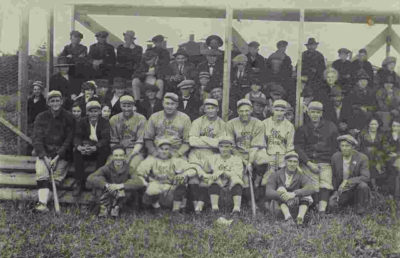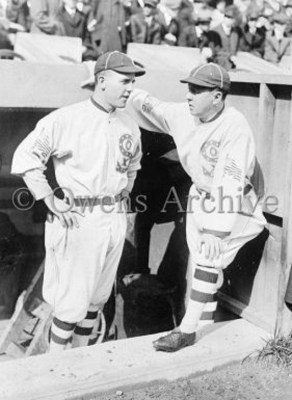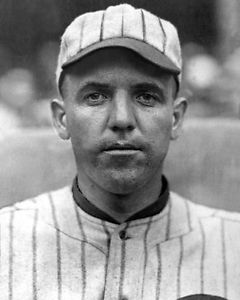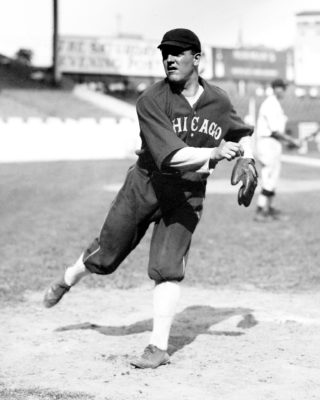Baseball History Comes Alive Now Ranked #2 by Feedspot Among All Internet Baseball History Websites and Blogs!
Guest Submissions from Our Readers Always Welcome!
Scroll Down to Read Today’s Essay
Subscribe to Baseball History Comes Alive for automatic updates. As a Free Bonus, you’ll get instant access to my Special Report: Gary’s Handy Dandy World Series Reference Guide!
Eddie Cicotte Photo Gallery
Click on any image below to see photos in full size and to start Photo Gallery:
Oh, Eddie!…Think What Might Have Been! Eddie Cicotte’s Great Span, 1917-1920
“I admit I did wrong, but I’ve paid for it the past 45 years.” -Eddie Cicotte, commenting in a 1965 interview
As many of you are aware I’ve written extensively about the 1919 Black Sox Scandal. I often think I may be the only person on the planet who doesn’t accept the conventional wisdom of what actually transpired during baseball’s darkest hour (see my book, Reflections On The 1919 Black Sox Scandal, Time to Take Another Look).
I read recently that Friday was the one hundred-sixth anniversary of Eddie Cicotte throwing a no-hitter against the St. Louis Browns in a game played on April 14, 1917 and won by the White Sox 11-0. So let’s turn our baseball spotlight again on Eddie Cicotte as we contemplate what might have been…
What’s notable about Eddie’s no-hitter is that it served as a harbinger of great things soon to follow. That season, after this auspicious start, the 33-year-old Michigan native went on to have a breakout year, with a 28-12 record (.700), and a 1.53 ERA over 346.2 innings, leading the league in all three categories. Throw in 29 complete games and seven shutouts and, by any measure, Eddie had truly a remarkable year. In the ensuing World Series, he continued his pitching excellence with a 1-1 record and 1.57 ERA over 23 innings as the up-and-coming White Sox defeated the Giants four games to two.

Following an injury-riddled 1918 season, he rebounded in 1919 with possibly the best year of his career, going 29-7 (.806), 1.82 ERA, and 30 complete games over 306 innings. He again led the league in wins, winning percentage, ERA, and innings pitched. Sadly, in 1920, the last year of his major league career, he was cruising along at a 21-10 clip when the scandal broke open and reared its ugly head in the last week of the season. With it came the end of Eddie Cicotte’s thus far brilliant career.
Eddie’s Composite 1917-1920
Looking at his composite stats during his 1917-1920 span, it’s obvious that Eddie had blossomed into a remarkably successful pitcher and was on the cusp of greatness. Over this four-year period, he went 90-48 (.652), with a composite 2.30 ERA, 111 complete games, and 17 shutouts. He averaged 306 innings each year.
It’s always interesting to speculate as to where Eddie would have ended up had the scandal not rudely intervened, which, of course, was entirely of his own making. His 14-season totals of 209-148 (.585), 2.38 ERA, 249 complete games, and 35 shutouts pitching for the Tigers, Red Sox, and White Sox certainly indicated his potential to become one of the elite pitchers in the history of the game. As a great knuckleballer, he could very well have stayed injury-free for another 6-8 years or even more, and this would have put him a pace for 300 wins and with it an automatic admittance into the Hall of Fame.
A Little More About Eddie’s Career
Eddie “Knuckles” Cicotte may be the most recognizable of the “Eight Men Out” after “Shoeless” Joe Jackson. His quote, “I did it for the wife and kiddies,” is the second-most famous line associated with the scandal, right after the apocryphal, “Say it ain’t so, Joe.” Eddie is also recognized as the first major leaguer to master the knuckleball. According to one description,

“Eddie gripped the knuckler by holding the ball on the three fingers of a closed hand, with his thumb and forefinger to guide it, throwing it with an overhand motion, and sending it from his hand as one would snap a whip.”
Eddie made his big-league debut on September 3, 1905, with the Tigers. After a 3-year stint in the minors, he resurfaced with the Red Sox where he compiled a 41–48 record from 1908 to 1912. The Red Sox sold him to the White Sox on July 22, 1912. He had a breakout year in 1913, going 18–12 with a 1.58 ERA. As mentioned above, he topped these numbers with great years in 1917, ’19, and ’20.
The Black Sox Scandal and the 1919 World Series
Eddie reportedly resisted repeated attempts by Chick Gandil to join in the plot to throw the 1919 World Series until just days before the series opened. The allure of easy money finally broke his resistance. He pitched in three games, winning one, but, pitching ineffectively, he lost the other two. Probably the most famous pitch he ever threw was the one that nailed Cincinnati Reds leadoff man Morrie Rath squarely in the back to lead off the World Series – a pitch that apparently signaled to the gamblers that the fix was on.
Eddie was the first of the eight players to come forward admitting guilt, signing a confession and a waiver of immunity. He later recanted this confession and was acquitted of all charges at the jury trial. But the joy was short-lived, as Judge Landis permanently banned Eddie and the seven other Black Sox for life.
Eddie’s Life After Baseball
After the scandal, Eddie returned to Livonia, Michigan, where he managed a service station and later became a game warden. He also worked for Ford Motor Company, retiring in 1944. At the time of his death on May 5, 1969, at age 84, he was a strawberry farmer in Farmington, Michigan. In an interview in 1965, he said he lived his post-baseball life quietly. He agreed that he had made mistakes, but insisted that he had tried to make up for it by being a good husband and father, and living as clean a life as he could after baseball.
We’re all responsible for the decisions we make in life – some better than others. How often in our own lives do we wish we could turn back the clock and undo an ill-conceived decision? Unfortunately, goaded on by the vile Chick Gandil, Eddie Cicotte made a bad one back in 1919; and he paid a steep price. It was one in which he had to live with the consequences for the rest of his life.
Oh Eddie…think!…think! What might have been…
Gary Livacari
Subscribe to our website, “Baseball History Comes Alive!” with over 1200 fully categorized baseball essays and photo galleries, now closing in on the one million hits mark with 958K hits and over 800 subscribers: www.baseballhistorycomesalive.com
Information: Excerpts edited from the Eddie Cicotte Wikipedia page





















Hi Gary,
Thanks for the highlights of what was a dominant few years by Eddie Cicotte. In his case it’s true he would have needed several more seasons to accumulate those all-time stats you note. But we still disagree on Shoeless Joe. Denying his entry to Cooperstown for more than 100 years after he was tossed out is a pretty severe penalty in and of itself. I know that when I go to the HOF I wish I could see his plaque and talk about his Black Sox transgression. Gordon and I would call it the ‘Corridor of Controversy’ in the HOF. Eddie wouldn’t be there but there would be more than just a couple of scarlet letter guys in there.
Thanks Mark. But there’s no disagreement. I’d love to see Joe enshrined in the Hall.One of my points has always been that there was different levels of guilt and the punishments should have reflected that. Instead a “one size fits all” sentence was meted out to all. That was also the point of Gene Carney’s book. Joe and Buck Weaver certainly deserved better treatment than some of the others.
Hi Gary…well, being the “Palehose” junkie that I am, I enjoyed this article very much. As a very young child, I learned of the 1919 WS, and eagerly tried to gather any and all information that I could about it. This and previous BHCA posts have indeed helped contribute to my knowledge. It was a VERY different culture in the baseball world in the early 20th century, and most of the players came from an entirely different, humble and meager background than today’s players do. Although today’s players are also exposed to many nefarious temptations, the players of the 1919 WSox had persuasive, mob-related swindlers influencing them to be involved in deeds that were impossible for at least 8 of them to resist. I am of the opinion that of the eight that were permanently banned, Shoeless Joe and Buck Weaver were the least culpable, and historians should emphasize that. Yes, Eddie Cicotte ruined what could have been a possible HOF-worthy career. At least he made the best amends that he could; by living out the remainder of his life honorably. Thnx for this great bio of him, Gary.
You bet Tom…and thanks for raising great points. I agree with all of them.
Enjoyed this one greatly, Gary. Thanks for your extended analysis of The Black Sox Scandal as laid out in your book, and other thought-provoking posts on the subject.
A question for Mark, Thomas, you and other readers: What’s the best explanation for the disconnect between these men’s jury verdicts of acquittal and the menacing, one-size-fits all edict of lifelong retribution from an all-powerful and unchallenged commissioner?
Thank you again,
Michael
Senor Keedy….IMHO, the “disconnect” you mention, is possibly due to this : the 1920 jury decision had more to do with the adulation and “hero-worshipping” of the indicted WSox Eight, rather than with the seriousness of their misgivings, whereas Judge K.M. Landis’ “non-negotiable” decision had to do with a coupla things…..{1} his “self-prescribed” ultimate authority, and {2} fulfilling the wishes of the owners {including Comiskey} to protect the game’s integrity, and not de-rail their future business interest {i.e.profit}.
Thnx for the thought provoking question, sir.
I am not sure there’s a best explanation but I am with Tom. IMHO Judge Landis was always cartoonish in his behavior.
Well said…
What you guys are saying certainly has the ring of truth. Thank you.
I may be doing Mt. Landis a disservice, but he always struck me as too willing to wield a tyrannical gavel.
When one has been vested with virtually unlimited power, as he was, it’s best to exercise it sparingly, and with a healthy dose of mercy. “IMHO,” as you might say!
Funny where this conversation is taking us, Doctor L! Did you see this coming?
Thanks again,
Michael
No not at all…but you never know!
Once again, Michael, you wield a mighty pen with “virtually unlimited power.” But, alas, I am usually “cartoonish” in my behavior. So, please, when you deal with me, and the likes of a Judge Landis, always exercise “a healthy dose of mercy.” IMHO, this has “a ring of truth.”
Clever…clever…
Wilhelm,
No promises, but I’ll see what I can do.
Mercy without justice is so somebody else.
Jus’ sayin’.
MHK
I’m just so afraid M that, despite your benign exterior, you wield a heavy gavel. And I still have that soft spot on the top of my head, right below the point.
You two guys are a stitch!
Just in time, too.